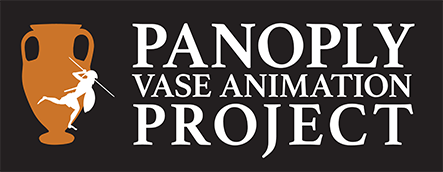The story was developed by pupils from Addington School in Reading as part of the Ure Discovery project. An Arts Council funded project run at the University of Reading’s Ure Museum of Greek Archaeology in 2013.
This gorgon is much smaller than the ancient Greeks’ idea of the gorgons; she’s tiny so that she fits into the cup.

That aside, the story in this animation is very much in the spirit of the ancient myth. The unsuspecting passer-by is literally petrified by the appearance of the gorgon and the warrior is only able to defeat her by ducking his head behind his shield and cutting her head off. The pupils at Addington School were very creative in their use of perspective. Instead of keeping to a single camera view, they used multiple angles, showing both the outside of the vase and the view of the inside that the passer-by has when he lifts it. By making us see from this character’s perspective, this view gives us a greater sense of his shock when the gorgon appears.
This is the storyboard created by the pupils from Addington School.

The vase this animation is primarily made from features only the head of the gorgon, not her full body. The body which you see is based on other ancient gorgon vase images, such as this one from the British Museum (below). The wings in particular are distinctive and common features in gorgon representations.

© The Trustees of the British Museum, 1849,0620.5
The gorgon’s victim is a figure from a second vase. His tunic is made from the throw over his arm, based on contemporary depictions of male clothing.

© Ure Museum (49.1.2)
Look for him in the Ure Discovery animation, Eros & Aphrodite.
The warrior is from a third vase - a lekanis from the island of Euboea (Ure Museum 56.8.8).

© Ure Museum (56.8.8)
He appears in Combat and Hoplites! Greeks at War.
The music on this animation is called Dithyrambos, which is a term referring to a sort of choral song to Dionysus. It was chosen because its rising rattling sounds suit the gradual appearance of the Medusa snakes. The music was created by ancient music specialist Professor Conrad Steinmann of Melpomen. Find out more about ancient music through our blog post on the subject and our interview with Prof. Steinmann.



